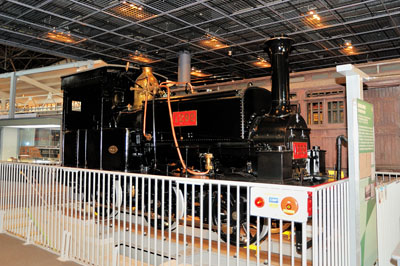
Steam Locomotive
Class 1290 |
One of the earlier steam locomotives imported for railroad construction. |

|
|
During 1874, two steam locomotives were imported for construction between Kobe and Kyoto from the British company Manning Wardle.
(manufactured numbers 431 and 435). At that time, the Osaka area was assigned to even numbers. According to this rule, they were named No.22 and 24. (The even and odd numbering rules were revised during 1876, consequently, I'm guessing that, those during 1873 and 1874 had other numbers during the imported time (No.22 was No.21?). But there is an absence of evidence in regard to it.
Construction was completed and opened on the 6th of February 1877, between Kyoto and Kobe, later No.22 and No.24 worked in the Osaka area with yard works. Afterward, they were used in the South part of Hokuriku (including a part of Tokaido) line construction and their class name was assigned "H" in 1885 and was changed again to class B1 during 1898. From the first No.22 and No.24 were imported and nine years later during 1882, one more similar engine was added. It had the Manning Wardle Co. manufactured number of 815 and named No.25. Japan's first private railway company "Nippon-Tetsudo Co." received No.25 engine as a transfer from Japanese government railway for their railroad construction.
No. 25 was shipped over Arakawa river to Kawaguchi town for Nippon-Tetsudo (Ueno-Kumagaya) line construction. Upon arrival, No.25 was located near Zenko-ji temple in Kawaguchi town. For that reason, she earned the nickname "Zenko". Nippon-Tetsudo company held a groundbreaking ceremony on the 1st of September 1882. The ceremony invited about 200 government officers and major stockholders. Invited guests were on the train which ran on the construction section of 4.5 miles between Kawaguchi and Oba, and they inspected construction. Zenko pulled the train, and she was considered to be the First-Engine of the Nippon-Tetsudo railway company. During 1894, Zenko-No.25 was named No.3 for the formal Nippon-Tetsudo Co's engine. But it was soon again changed to Kou-1, for the reason that Ballast-Engines were named Class "Kou". During May 1905, Kou-1 was used at the Ueno depot and used for swinching operations. During 1906, Nippon-Tetsudo Co. was nationalized. Kou-1 became the government railways engine with No.22 and No.24. They were renamed to class 1290, and Number 22 was changed to No.1290, No.23 to No.1291 and ex-No.25 Kou-1 to No.1292 when class names were revised during 1906.
Afterward, No.1292 was operated for swinching in the Nagoya area until 1923 and retired. However, she was not scrapped because of the highly-noted engine name "Zenko". Later she was preserved at the Tokyo Railway School in Ikebukuro for safekeeping. She was later moved to Manseibashi's Railway Museum during 1940 with the "Benkei 7100". During October 1959 Zenko was designated a Railway Monument. During October 2007, she was moved to Saitama with the museum's new relocation. |
|
Class 1290, No.1292 Zenko Biographic Data Chart
| |||||||||||||||||||||||||||||||||||||||||||||||||||||||||
|
Introduction |
Go to Top |